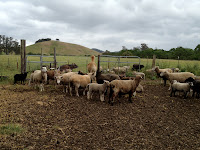Spinning Class 2
Second class in a series of three on spinning and dyeing. To think that I felt a little ill that morning and thought about calling in sick! Oh duh! By the time class was over, and it ran into overtime, I felt fit as a ... new lamb. The sheep had been moved to a new field and they were bleating all afternoon. It was really pleasant to listen to the ewes call to their lambs.
This class was packed with things to learn. We started with show and tell. What had we spun in the time since the last class? True confessions and owning one's over spun creations. Then the roving was passed out and we were taught how to do the long draw. Woolen, I think, as opposed to worsted. It doesn't seem like it should work to pull the roving back and back with left hand, free the spun end which has been storing the twist, and watch the spin zip through the roving ... and stop. Like magic! Mr. Schacht pulled the spun roving through and we were ready to go again. A process that was not always successful as Mr. Schacht is very greedy and treats the roving like spaghetti. This way of spinning results in an airy yarn that is good for projects where there is no obvious pattern.
 Next we examined raw fleece and looked at the crimp. Less crimp: less spring in the yarn. More crimp and the yarn/sweater/scarf will regain it's shape after washing. She also showed us the roughest alpaca fleece and the softest, which came from a yearling. The contract between the two fleeces was startling.
Next we examined raw fleece and looked at the crimp. Less crimp: less spring in the yarn. More crimp and the yarn/sweater/scarf will regain it's shape after washing. She also showed us the roughest alpaca fleece and the softest, which came from a yearling. The contract between the two fleeces was startling.We spent a really fun and frenzied time creating art batts with a drum carder. Our teachers are thinking of creating a drum carder lending "library" as the machines are expensive and used ones are hard to find. I wish they would, that would work for me. Although having a smaller machine might be possible if I save my dimes and quarters and dollars and Euros. It is so much fun to feed roving, silk noil, acrylic fibers, etc., etc. into the carder and watch it move through those teeth and become light and airy and something one can spin. Homework now is to spin our batts into yarn and ply it.
 |
| Too much twist? |
Last lesson of the day was to ply those balls of crinkly singles we spun over the last week. Yes, plying is supposed to take the twist out and I suppose it did... a little. My kind teacher says that it I have art yarn and she can sell it for a good price at the farmers' market. More homework: wash and set the plied skeins and hope the twist falls out.
Wish me luck!



